#Buffalo Renaissance
Explore tagged Tumblr posts
Text
At Long Last, The American Buffalo Has Come Home
A conservation effort has returned bison to Blackfeet Nation tribal lands more than a century after the animal was nearly slaughtered to extinction.
— Photographs By Louise Johns | By Lailani Upham | Sunday July 09, 2023
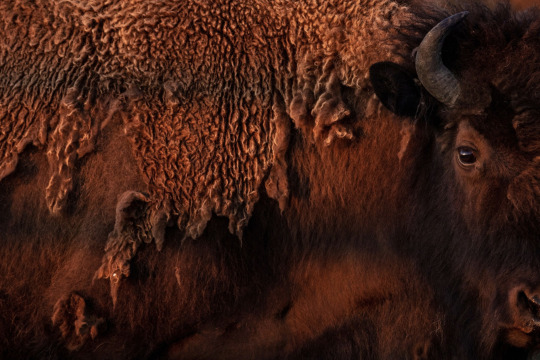
“Nititawahsi” is the Blackfeet name for our land—the land where the iinnii (buffalo) live. Our people are Niitawahsin-nanni: the people of the land where the iinnii live.
As colonizers moved west, millions of buffalo were killed and brought to the edge of extinction. Millions more Native peoples were murdered, displaced, and forced to assimilate. By the end of the 19th century, only 300 buffalo were left in the wild and Native populations dropped to less than 300,000.
Now, after more than 150 years, iinnii have finally returned to their homeland, the Amskapi Pikuni (Blackfeet Nation) tribal lands, to roam free.

Forty-nine buffalo run out of their temporary enclosure towards Chief Mountain on the Blackfeet Reservation. The rest of the herd (about 70 buffalo) will join them at the end of the summer. Chief Mountain is not only prime buffalo habitat, but also a sacred place for Native people in both the U.S. and Canada.
“I can’t hardly describe the feeling that I have. I have this jittery feeling, goosebumps,” says Ervin Carlson, director of the Blackfeet Nation Buffalo Program. “It just feels so good to finally see them here in this place where we want them to be.”
On June 26, 49 iinnii were released into the wild at the base of our sacred Ninaistako (Chief Mountain), a Strong Miistaaki (Mountain) that stands tall like the warbonnets of Blackfeet warriors. This miistaaki towers along the border of the Blackfeet Nation, Glacier National Park in Montana, and Waterton National Park in Canada.
Our people, the Siksikaitsitapi (Blackfoot Confederacy) always believed the land we came from was a gift of the Creator, Ihtsi-pai-tapi-yopa. Our stories tell us that iinnii was created as a gift for our people as our life source. The iinnii were and still are our staff of life.
The iinnii coming back and being free on Blackfoot lands again is the beginning of reconciliation, says Cristina Mormorunni, director of Indigenous Led, the organization that leads cultural restoration and conservation of buffalo on Blackfoot lands. “This is the beginning of the truth being told about what happened, and they’re the best ambassadors,” she says.


Helen Augare, a Blackfeet knowledge keeper and director of the Blackfeet Community College Native Science Field Center, has been an integral voice in the return of buffalo to Chief Mountain for the past 15 years.
Now that the buffalo are free, she says “there’s so much still to reconnect to and learn from them.”
“What does that future look like and what [do] our children and grandchildren need to know to be able to help iinnii live a full and prosperous life with us again?” Augare says. “It entailed everything from healthy people, healthy land, healthy water, and most of all healthy relationships. That in itself requires a lot of healing, growth.”
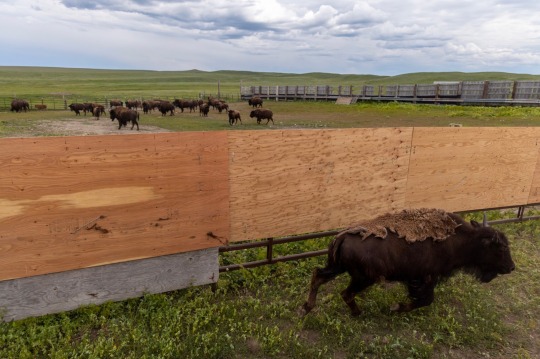
Buffalo are corralled and sorted (calves from adults, and males from females) at the tribal-owned Buffalo Spirit Hills Ranch on June 25, 2023. The herd, originally from Canada’s Elk Island National Park, have been living on the ranch since 2016. The herd descends from the last remaining wild buffalo before they were nearly extirpated.

Blackfeet tribal member Wyett Wippert takes a photo of his daughter, Ruby, in front of the buffalo in their soft release pen at Chief Mountain. “We put so much of our hearts into getting them here,” he says. “It’s a very good feeling knowing that they are under Chief Mountain. People know what they’re going to be doing for their environment and for us as Blackfeet people.” The buffalo are held here for several hours to settle into their surroundings before being released into the wild.

Racine, Monroe, and director Ervin Carlson of the Blackfeet Buffalo Program, on June 25, 2023, after a long day of preparing buffalo to be released at Chief Mountain. “It’s a lot of work to get these animals to this point… they are wild buffalo,” Racine says. “Nobody can do it by themselves. It’s a real honor to be able to have the Iinnii here and to be doing this.”
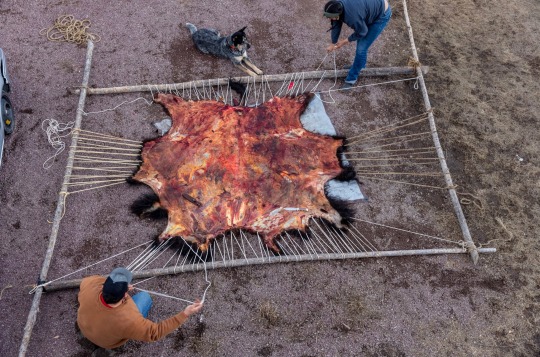
Blackfeet tribal members Wyett Wippert and Christen Falcon work together to stretch their bison hide onto their handmade wooden frame, the first step in tanning the hide by hand at their home in East Glacier, Montana. on April 9, 2023.
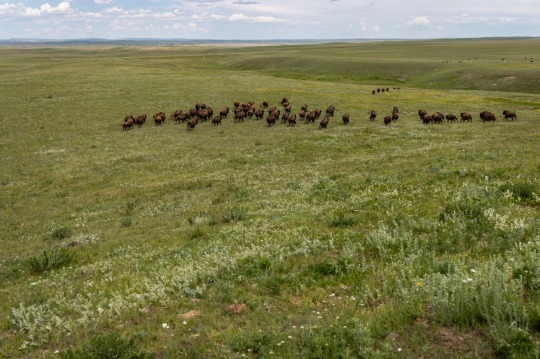
“Bison are a keystone species, they are ecosystem drivers and engineers. They were here for thousands of years,” says Brandon Kittson, wildlife biologist for Blackfeet Fish and Wildlife. “Now having them back on this landscape is a good thing. It’s going to help revitalize some systems and help drive diversity among the different vegetation and communities found in this area.”
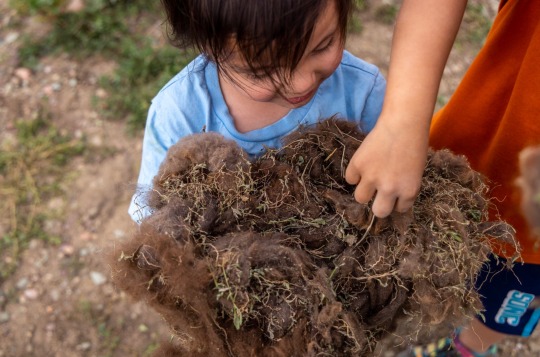
Children collect and examine clumps of buffalo fur from the corral at Buffalo Spirit Hills Ranch on June 25, 2023. The fur is integral to the health of the grassland ecosystem, as certain species of birds use it to line and insulate their nests.
— Photojournalist Louise Johns is a National Geographic Explorer. Her National Geographic Society-funded Project, "Buffalo Renaissance," is about Native American efforts to restore Bison to build cultural resiliency and ecological integrity.
#The National Geographic#American Buffalo#Photojournalist#Louise Johns#Buffalo Renaissance#Amskapi Pikuni (Blackfeet Nation)#Niitawahsin-Nanni#Chief Mountain#Ninaistako (Chief Mountain)#Glacier National Park in Montana#Waterton National Park in Canada#The Siksikaitsitapi (Blackfoot Confederacy)#Cristina Mormorunni#Helen Augare#Montana USA 🇺🇸#Canada 🇨🇦#Brandon Kittson Wildlife Biologist#National Geographic Explorer
33 notes
·
View notes
Text










pt.48!! <pt.47 pt.49>
!! jolinda renaissance !!
tags for the homies ❤️ @andrewsleftarmband @blurryhour @you-know-i-get-itt @notexactlythatgirl @longspacerat @tessasilverswan @minyard-05 @carbon-dated-gal @bisexualchaosdemon @stormiiflies @watercoloureyes01 @vampire-overlord @iron-sides @azure-wing @buffalo-fox @ohgodnotagainplease @pink-hydrangea @jaywalkerss @ohmynoggin-blog @cosmic-marauder @min-getoutofmy-yard @plazybones @disastersappho @leestars13 @the-witch-forever-lives @minyardsss @post-historical-posts @andabuttonnose @hidinginmyhands @aftg4l @allfor-thegames @kaleidoskuls @inafieldofstarflowers @snowcoming @mooniism @jeanmoreausautismstickers @prometheusthedragon @graveyardviolence @bustedleftshoe @beatrix33 @aftg-bs @yes-i-exist-shutup @milktemproom
#crystals are more of an idea really#cool rock? that’s a crystal#dishwasher tablet? cleansing crystal#eraser? artistic endeavours and new beginnings crystal#renee walker crystal* collection is very dear to me#*crystal adjacent#aftg#aftg socmed au#aaron minyard#renee walker#nicky hemmick#neil josten#andrew minyard#kevin day#matt boyd#allison reynolds#dan wilds#seth gordon#laila dermott#jean moreau#cat alvarez#aftg social media au
692 notes
·
View notes
Text
i think economic depression is so ideologically incompatible with most usamericans' self-conception that they cannot recognise it even when they have been living through it for several consecutive decades. this is why people from buffalo new york are always telling you there's about to be a buffalo new york renaissance any day now
329 notes
·
View notes
Text

April Fools 2024: The Curious Case Of The Chunky-Necked Ceratopsians
Much like the aquatic Compsognathus featured here a couple of years ago, not every novel idea that came out of the Dinosaur Renaissance was a winner.
And one of the oddest examples came from author/illustrator John C. McLoughlin.
His 1979 book Archosauria: A New Look at the Old Dinosaur featured an unusual interpretation of ceratopsian dinosaurs' characteristic bony frills, proposing that they were actually muscle attachment sites for both powerful jaw muscles and enormous back muscles to help hold up their large heavy heads. This would have completely buried the frill under soft tissue, giving the animals massive thick necks and humped shoulders, and resulted in an especially weird reconstruction of Triceratops with a grotesque sort of wrinkly sewn-together appearance.
This concept didn't entirely originate from McLoughlin – three years earlier in 1976 he'd illustrated Ronald Paul Ratkevich's book Dinosaurs of the Southwest, which seems to have been the inspiration for Archosauria's fleshy-frilled ceratopsians. A few paleontologists had also proposed jaw muscles attaching onto the frills during the 1930s and 1950s, and there's even a book from as far back as 1915 that also shows the top of a Triceratops' frill connected to its back! But McLoughlin's Archosauria image is still by far the most extreme and infamous version of the idea.
There were a lot of things in Archosauria that were actually very forward-thinking for the time period, such as putting fuzz and feathers on small theropods and depicting non-avian dinosaurs as active fast-moving animals. The unique ceratopsian reconstructions, however, never caught on for several big reasons:
Firstly, all that hefty muscle tissue would have locked ceratopsians' heads firmly in place, unable to move at all, which just doesn't make sense biomechanically. Then there was the lack of skeletal evidence – muscles that big should have left huge visible attachment scars all over the frill bones, and there was no sign of anything like that on any fossil specimens. Finally, it turns out the ceratopsian head-neck joint was actually highly mobile, suggesting their heads were free to make a wide range of motions in life.
As wrong as they were even at the time, McLoughlin's ceratopsians were still an interesting speculative idea, and notable for advocating for fleshier dinosaur reconstructions at a time when paleoart was trending towards shrinkwrapping.
Further reading under the cut:
A Very Alternative View of Horned Dinosaur Anatomy, Revisited – https://tetzoo.com/blog/2020/11/22/alternative-view-of-horned-dinosaur-anatomy
Trope of the Buffalo-Backed Dinosaur – https://tetzoo.com/blog/2020/11/27/trope-of-the-buffalo-backed-dinosaur
Vintage Dinosaur Art: Archosauria - Part 3 – https://chasmosaurs.blogspot.com/2013/10/vintage-dinosaur-art-archosauria-part-3.html
Vintage Dinosaur Art: Dinosaurs of the Southwest – https://chasmosaurs.blogspot.com/2016/11/vintage-dinosaur-art-dinosaurs-of.html
The Forgotten John C. McLoughlin Book – https://www.manospondylus.com/2021/03/the-forgotten-john-c-mcloughlin-book.html
#april fools#inaccurate paleoart#retrosaurs#science illustration#paleontology#paleoart#palaeoblr#triceratops#ceratopsian#dinosaur#art#mcloughlin ceratopsians#they are very shaped#she's beauty she's grace she can't even turn her face
326 notes
·
View notes
Text
HUgE Jan 2011
infocus
truth is in the DETAILS

ITEM: SILVER RING
BRAND: Le Taboux HYSTERIC GLAMOUR
MATERIAL: STERLING SILVER
SIZE: FREE WEIGHT: 37.3g (lion amuleto), 18g (skull maria face)
MADE in JAPAN
Strong yet delicate silver jewelry
The collaboration between Hysteric Glamour and Le Taboo began in 2008. To date, the pair have developed collections that exude a unique worldview, inspired by the Romanesque, Gothic and Renaissance styles of medieval Europe, as well as Greek mythology. The pieces, born from innovative methods of expression and the sophisticated techniques required to realize them, are all attractive for their three-dimensionality and sharp edges, as if they were one-of-a-kind sculptures.
It has a mysterious presence that attracts those who see it.
Makoto Maeda, who is in charge of Le Taboo, supported the founding of Bigi in the 1970s and moved to France in 1974. He has worked as a designer and director of ready-to-wear and haute couture for various brands. "His collections are powerful yet delicate. For example, the expression of the skull has a certain elegance to it, and it is good that it is neither too masculine nor too feminine. I think that it can only be expressed with a deep understanding of the motif," says Nobuhiko Kitamura. The sensibility cultivated during his long life in Europe brings depth to his creations.
The two works introduced here, "Skull Maria" and "Lion Amuleto", are the latest in a series of works created by contemplating the life of an imaginary nun. The texture of the veil of the nun's robes, the graceful wrinkles on the lion's cheeks, and the beautiful fine workmanship are all beautiful, making these masterpieces a perfect display of the characteristics of "Le Taboo".

The latest model in the collaboration series between the accessory brand Le Taboo, which started in 2005, and Hysteric Glamour.
In addition to these, the Aoyama store will have the entire Le Taboo x Hysteric Glamour collection, including past models. From top to bottom, Lion Amulet ¥44,100, Skull Maria Face ¥29,400, Skull Maria ¥44,100 (all Hysteric Glamour)

ITEM: ANKLE BOOTS
BRAND: EMPORIO ARMANI
MATERIAL: BUFFALO LEATHER (upper),
RUBBER (cutsole) COLOR: BLACK SIZE: 39~44cm
SIDE ZIP, MICRO STUDS at THE ANKLE, EGG TOE, MIDDLE LENGTH, MADE in ITALY
Ankle boots that combine volume and sophistication
This season, Emporio Armani presented their collection under the theme of "Geometric Theorem". The balanced beauty of geometry is connected to the authenticity of menswear. Sometimes cool, sometimes bold, they portrayed masculinity. They expressed the energetic masculine image that underpins the brand in a clear and modern way.
Boots were proposed as an item suitable for decorating the feet. They appeared frequently on the runway of this collection, and there were various items such as command and work types.
The lineup includes a wide range of styles, including a voluminous silhouette and a sophisticated egg-toe shape, which reflects the attention to detail of designer Giorgio Armani.
The ankle boots, made from high-quality buffalo leather and featuring a side zip, are no exception. As a simple model with no seams from the toe to the ankle, the volume and shape of the boots are more clearly defined. In addition, the heel is evenly spaced with small studs and the thin sole adds a sharp impression. Of course, the Italian-made construction ensures a high-quality fit.
Simple designs with meticulous attention to detail. This may be the reason why Emporio Armani, which celebrated its 30th anniversary in 2011, is still going strong.

Emporio Armani was launched in 1981 with a more free-thinking approach. For the 2010 Fall/Winter season, which has a theme of "geometry," the brand has developed a collection that boldly incorporates shapes such as circles, triangles, and squares in a grayish color palette. Also look out for outfits that use boots. Adding volume and accents to the feet creates a more masculine impression. ¥81,900 (Giorgio Armani Japan)
#my scans#fashion#avantgarde#2010s fashion#japanese fashion#archive fashion#giorgio armani#emporio armani#hysteric glamour#sterling silver#jewlery#skull#lion#leather boots#silver jewelry
8 notes
·
View notes
Text
Starting Materials for Mediterranean Trancework
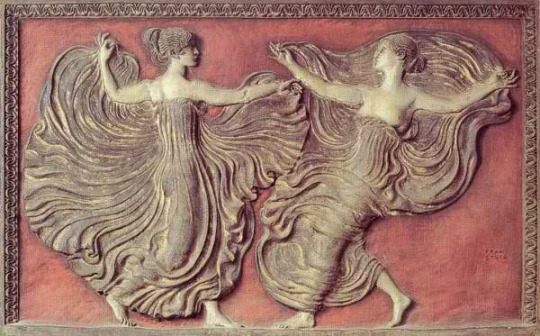
If you are wondering what you will need to get started on this as a group, I have put together a list of materials. This is basically what I use when I am teaching others how to do this and when I host trance rituals.
I keep a fully stocked trance kit with extras of all the below items so that those who need them can have something to use until they can get their own. If you intend to lead your own group, be prepared to provide at least a few things for the effort.
Frame Drums: 14”-16” frame drums with synthetic heads are best for beginners. Recommending Remo’s Thinline, Renaissance, Fiberskyn, or Tar series’. Synthetic heads help students build up skills and needed hand calluses at the same time. Goat or fish skin drum heads will tear up your skin and go flat without proper care very easily. Each person involved should know how to play a drum and learn the beats your group uses. Avoid buffalo drums and bodhrans, they are too heavy for Mediterranean style drumming.
Whiteboard and Easel: A wooden repurposed child’s art easel will work perfectly fine. Use it to balance a whiteboard where you can put up weekly notes. Large clips or magnets can be used to hold up a poster-board too, depending on what kind of easel you get. These are great for keeping up your trance chant lyric notes. Only use a whiteboard for notes that you will need once.
Poster Boards: Record trance chants and rhythms that you use with your group onto large poster boards so that everyone can read them during practice sessions. Use a poster-board for notes that you will need multiple times to spare yourself from writing it again and again every time you need it.
Trance Rhythms: I start folks out with 10 trance rhythms that can be used for pretty much everything. They work for just about any Mediterranean song you can find. I will have to film some samples for this so that you can hear them.
Trance Chants: To get through a basic trance ritual, you will need roughly 4-5 trance chants. Start your group with their first 5 and work on getting them down together. Some groups will prefer to work with songs in English, some will prefer songs in other languages, and some will prefer a mix of both. Feel out your group before you decide on your chants.
Online Database of Communication: Start up a group where you can share resources, communicate about upcoming trance dates, and load up videos privately. Keep it secure.
Incense: Incense is a trance trigger so pick one scent and stick to it every time you do practice or ritual. Keeping the same scent for all things trance will help participants go under. Use a soft floral scent like jasmine. Later, you can work in different scent triggers for different rituals.
Rug: You can use rubber gym mats that link and/or an actual rug. Rugs will give rug burns so plan accordingly. Whatever you use has to be easily perceived by touch rather than sight--so tape on the floor will not work. This well defined border will be where the entranced are free to move. They will confine themselves to it so make sure it is the right size for the job you want it to do.
White Flat Sheets: You will need at least 2 to start and +1 for each additional person who will trance. You can have your participants bring their own or you can pick some up from a second-hand store for fairly cheap. Everybody should have their own if possible.
Colored Scarves: All things are color coded in trance for hypnotic suggestion and we use colored scarves to communicate with each other during trance rituals. People who wear a red scarf are monitors who look after trance dancers, people who wear white scarves are trance dancers who are there to trance, people who wear light blue scarves are musicians, and people who wear dark blue scarves are ready and capable of leading a trance session. You can have people bring their own or supply the group yourself.
Your “Whites”: Each person will need an all white outfit to wear during trance rituals. For class, they can wear whatever they like. White is a spiritually neutral color used by all Mediterranean trance cults. Participants should supply their own trance clothes but you can keep a small supply of extra items to help supplement.
Altar Kit: A trance altar needs to have a water jug and rinsing bowl with scented water for participants to wash their hands and face at (Cortas brand rose or orange blossom water are easy to find at Mediterranean groceries). It will need incense for participants to smudge themselves, their clothes, their hair and their instruments with. It will need a plate for monetary donations (it should never be empty). It is lucky to put an odd number on the altar ($1, $3, $5, $7 or $9). It will also need essential oils for use on skin that participants can rub on themselves (floral, fruit, or herbal scents preferred). Scent is very important to trance so the key is to be consistent and use it liberally so the scent can work as a non-visual trigger.
Wake-up Kit: A pitcher or fancy spritz bottle of cool water to spray or sprinkle on the arms and forehead of the entranced when they are done trancing. A blended oil of strong purgative scents that is dabbed on the fingers of the guide or monitor and wiped on the nose of the entranced when they are done trancing. I prefer a blend of rosemary, cedar and clove oil--that’ll wake you up! Make sure that no one in the space has an allergy to a product you use.
Food: Always keep at least a loaf of fresh bread and some hummus for dipping on hand for post-trance snacks. Eating food helps those who have been trancing to come down and sober up. Water to drink is also helpful afterward. Be aware of dietary restrictions before you bring in foods that members of your group cannot eat.
Symbols: Think very carefully about the symbols you use and when you use them. Protect their meanings by bringing them out only when they are relevant. Continually reinforce their meanings in all that you do. This is a hypnotic suggestion and your symbols will become more and more important the more trancing you do.
60 notes
·
View notes
Text
Fics Masterlist
Multi Ship
Daniel’s Day at a Kissing Booth (College AU: Maxiel, Dewis, Jenson/Daniel)
The Viscountess Wolff (Regency AU: Lewis/Toto & Elkilton)
ASOIAF AU (Sebastidan, implied Sebastian/Max)
We've Never Hooked Up Part 2 (Elkilton, Lewis/Toto, Implied George/Toto)
Daniel and His Harem of Boyfriends
Ch. 1 ● Ch. 2 ● Ch. 3 ● Ch. 4 ●
Blurbs
Max ● Dosh First Meeting ● Dewis ● Josh Persona Non-Grata ● Chaniel Vegas ● Dosh Playoffs Loss Comfort ● Dosh RB Car Launch ● Boyfriends Against Will Buxton ● Grill the Grid ● Boyfriends Against RB Sponsor
Maxiel
Max Universe Switcharoo
Max False Pregnancy
Zandvoort 2023 - “Are You Hurt?”
Movie Star Daniel/Bodyguard Max
Tattoo Me
"Do You Want Me To Stay?"
Batman AU ● Batman’s Lip Freckle
WAG Max
Renaissance AU Part 1 (Daniel)
Game of Thrones AU
Gravitating Closer
Reincarnation
The Beauty of Their Dreams (Political AU)
Ch. 1 ● Ch. 2 ● Ch. 3 ● Ch. 4 ●
Blurbs
First Meeting ● Iowa Campaign Trail ● Why Daniel Married Max ● Daniel Choosing a College ●
Elkilton (LHxJE)
Lewis Signs With Ferrari
Valentine's Day
Domestic Snippet
John Courting Lewis
Saudi Arabian GP 2024
Accidental Marriage
HOTD AU
Take A Risk
Ch. 1 ● Ch. 2 ● Ch. 3
Scaniel
Scotty's Wedding
Scanielax Historical AU P2
Sewis
Lewis to Ferrari
Detective/Art Thief (past brocedes)
Dewis
Painting with Pups
Fake Dating
College AU
Angel/Demon AU
WAG Lewis
Helmet Designer Daniel
Royalty AU
Part 1 (Lewis) ● Part 2 (Daniel)
Brocedes
Undercover Agents
Elevators
Sebcedes
Omegaverse Unplanned Pregnancy
Dosh
LA to Buffalo: Or What Daniel Does During the Vegas GP
Post-Game Rituals
Daniel/Jenson
Professor/Student AU ● Part 2
Stuck on a Deserted Island
Tudor AU
Other
Comfort (Daniel/Blake)
Omega Lewis (Lewis/Charles)
Single Parent AU (Dando)
20 notes
·
View notes
Note
i have no reason to send this ask other than i felt like you'd enjoy this picture i took today of a puppy kissing a water buffalo at an italian cheese farm

have a good one and i luv ur blog <3
renaissance painting
68 notes
·
View notes
Text

Ishmael Scott Reed (February 22, 1938) is a poet, novelist, essayist, songwriter, playwright, editor, and publisher known for his satirical works challenging political culture. Perhaps his best-known work is Mumbo Jumbo (1972), a sprawling and unorthodox novel set in 1920s New York.
His work has often sought to represent neglected African and African American perspectives; his energy and advocacy have centered more broadly on neglected peoples and perspectives, irrespective of their cultural origins.
He was born in Chattanooga. His family moved to Buffalo when he was a child. He attended the University at Buffalo. He withdrew from college in his junior year, partly for financial reasons, but mainly because he felt he needed a new atmosphere to support his writing and music. In 1995, the college awarded him an honorary doctorate.
Among writers from the Harlem Renaissance for whose work he has expressed admiration are Langston Hughes, Zora Neale Hurston, George Schuyler, Bruce Nugent, Countee Cullen, and Arna Bontemps.
He moved to New York City and co-founded the East Village Other. He was a member of the Umbra Writers Workshop, some of whose members helped establish the Black Arts Movement and promoted a Black Aesthetic. He never participated in that movement, he has continued to research the history of African Americans. While working on his novel Flight to Canada, he coined the term “Neo-Slave narrative”, which he used in 1984 in “A Conversation with Ishmael Reed”. He made connections with musicians and poets such as Sun Ra, Cecil Taylor, and Albert Ayler.
He began teaching at UC Berkeley, where he taught for 35 years. He is serving as a Distinguished Professor at California College of the Arts. He lives with his wife of more than 50 years, Carla Blank, a noted author, choreographer, and director.
He is the founder of the Before Columbus Foundation, which since 1980 has annually presented the American Book Awards and the Oakland chapter of PEN, known as the “blue-collar PEN”, which gives annual awards to writers. #africanhistory365 #africanexcellence
3 notes
·
View notes
Note
Barb anon is backkk did I end up procrastinating to reply yessssss has it been whole month into the new year yah but we aint gonna talk about that but since your going on your hiatus wanted to sent this in FIRSTTTT OFFF GIRLL YOU GOT THIS MAKE NICKI PROUD CUZ BARBZ STAY IN SCHOOLL AND SHOW HER YOUR MBA 🤭🤭🤭 but yah school fr be annoying as hell especially when your also working and have extracurriculars so it’s understandable that your taking a break from on here
Also I am not sure if these emojis are take so I will instead just give an emoji combo 🌙🎱
I just remembered u had recently went to whistler as someone from the metro Vancouver area all imma say is I was kinda confused (me fr:😨🫢😗) since I was pretty sure your from the states and then I saw the tiktok ban post u made which confirmed u weren’t Canadian and I was pretty gagged that my fav writer is fr 2 hours away rn and i am at home (idk why I can’t fathom stuff like this like I fr couldn’t sleep when I realized during renaissance tour Vancouver date that Beyoncé is 40 mins away from me and I was going to the show so I was gonna see her as well 😭😭😭) so I wanted to ask is whistler known as a tourist spot in the states cuz I mainly thought whistler was Canadian spot and maybe Australian/uk spot since so many people working in the village are from there
Anyway good luck with school sending loads of love ❤️❤️❤️
AHHHHH BAEEEE Barb nonny boo!! 💕💕💕
aweee thank youuuu sweets! haha i need to go over to stationhead and get a nicki scholarship lmfao XD.
yeah im just stressing, ive been stressing all week so i havent really been able to relax and enjoy writing anything. plus searching for an apartment is STRESSFUL! like i put in a app today and then when it confirmed the price went up $250! Like how you gonna change my price mid application!?!?! im ded.
Ooh yeah! I've gone up to whistler for the past 2 years with my MBA friends and we are gonna make it a tradition haha. I'm in WA so I'm just below y'all!
Yeah I think in the PNW at least its popular. I was surprised how many UK/Aussies are there, especially Aussies, everyone working there is Aussie istg haha. I really like it there and I dont even fuck with snow like that haha, but the vibes are so fun and I like going to dance at Buffalo Bills. We rent airbnbs like right across the street from the village cause its better than the hotels imo.
Thank youuu barb anon love u boo tysm for the support. Reading this helps me keep going cause its way too much on my plate that i just kinda panic and freeze lately lolol. Then i take a puff of my vape and pull my shit together but I feel like i have a freak out moment everyday lolol.
but miss y'all alreadyyyy i cant wait until this school year is over and i can go to portugal then come back to y'all!🩷🩷


2 notes
·
View notes
Text
Full List of Grammy 2025 Winners
The full list of 2025’s Grammy winners can be found below. Song of the Year Beyoncé – Texas Hold ’Em Billie Eilish – Birds of a Feather Chappell Roan – Good Luck, Babe! WINNER: Kendrick Lamar – Not Like Us Lady Gaga & Bruno Mars – Die With a Smile Sabrina Carpenter – Please Please Please Shaboozey – A Bar Song (Tipsy) Taylor Swift Featuring Post Malone – Fortnight Record of the Year The Beatles – Now and Then Beyoncé – Texas Hold ’Em Billie Eilish – Birds of a Feather Chappell Roan – Good Luck, Babe! Charli XCX – 360 WINNER: Kendrick Lamar – Not Like Us Sabrina Carpenter – Espresso Taylor Swift Featuring Post Malone – Fortnight Best Pop Duo/Group Performance Ariana Grande, Brandy & Monica – The Boy Is Mine – Remix Beyoncé Featuring Post Malone – Levii’s Jeans Charli XCX & Billie Eilish – Guess Featuring Billie Eilish Gracie Abrams Featuring Taylor Swift – Us. WINNER: Lady Gaga & Bruno Mars – Die With a Smile Best Latin Pop Album Anitta – Funk Generation Kali Uchis – Orquídeas Kany García – García Luis Fonsi – El Viaje WINNER: Shakira – Las Mujeres Ya No Lloran Best New Artist Benson Boone Doechii WINNER: Chappell Roan Khruangbin Raye Sabrina Carpenter Shaboozey Teddy Swims Best Country Album WINNER: Beyoncé – Cowboy Carter Chris Stapleton – Higher Kacey Musgraves – Deeper Well Lainey Wilson – Whirlwind Post Malone – F-1 Trillion Best Pop Vocal Album Ariana Grande – Eternal Sunshine Billie Eilish – Hit Me Hard and Soft Chappell Roan – The Rise and Fall of a Midwest Princess WINNER: Sabrina Carpenter – Short n’ Sweet Taylor Swift – The Tortured Poets Department Best Rap Album Common & Pete Rock – The Auditorium Vol. 1 WINNER: Doechii – Alligator Bites Never Heal Eminem – The Death of Slim Shady (Coup de Grâce) Future & Metro Boomin – We Don’t Trust You J. Cole – Might Delete Later Best Contemporary Classical Composition Andrea Casarrubios – Casarrubios: Seven for Solo Cello Decoda – Coleman: Revelry Esa-Pekka Salonen, Fleur Barron, Nicholas Phan, Christopher Purves, Axelle Fanyo & San Francisco Symphony Chorus & Orchestra – Saariaho: Adriana Mater Eighth Blackbird – Lang: Composition as Explanation WINNER: Los Angeles Philharmonic, Gustavo Dudamel & Los Angeles Master Chorale – Ortiz: Revolución Diamantina Best Classical Compendium Amy Porter, Nikki Chooi, Buffalo Philharmonic Orchestra & JoAnn Falletta – Lukas Foss: Symphony No. 1 & Renaissance Concerto Andy Akiho & Imani Winds – BeLonging Danaë Xanthe Vlasse, Royal Philharmonic Orchestra & Michael Shapiro – Mythologies II Experiential Orchestra, James Blachly & Curtis J Stewart – American Counterpoints WINNER: Los Angeles Philharmonic, Gustavo Dudamel & María Dueñas – Gabriela Ortiz: Revolución Diamantina Best Arrangement, Instruments and Vocals Cody Fry Featuring Sleeping at Last – The Sound of Silence John Legend – Always Come Back WINNER: Säje Featuring Regina Carter – Alma Willow – Big Feelings The 8-Bit Big Band Featuring Jonah Nilsson & Button Masher – Last Surprise (From “Persona 5”) Best Arrangement, Instrumental or A Cappella Béla Fleck – Rhapsody in Blue(Grass) Henry Mancini & Snarky Puppy – Baby Elephant Walk (Encore) WINNER: Jacob Collier Featuring John Legend & Tori Kelly – Bridge Over Troubled Water Säje – Silent Night Scott Hoying Featuring Säje & Tonality – Rose Without the Thorns Best Musical Theater Album WINNER: Hell’s Kitchen Merrily We Roll Along The Notebook The Outsiders Suffs The Wiz Best Spoken Word Poetry Album Malik Yusef – Good M.U.S.I.C. Universe Sonic Sinema Episode 1: In the Beginning Was the Word Omari Hardwick – Concrete & Whiskey Act II Part 1: A Bourbon 30 Series Queen Sheba – Civil Writes: The South Got Something to Say Skillz – The Seven Number Ones WINNER: Tank and the Bangas – The Heart, the Mind, the Soul Best Classical Solo Vocal Album Fotina Naumenko – Bespoke Songs Joyce DiDonato, Il Pomo d’Oro & Maxim Emelyanychev – Wagner: Wesendonck Lieder WINNER: Karen Slack & Michelle Cann – Beyond the Years Nicholas Phan, Farayi Malek &… https://chorus.fm/news/full-list-of-grammy-2025-winners/
2 notes
·
View notes
Text
ACT II
I spent a lot of time with Beyonce's new album. I think it's just, .. it's impressive, in a way that only someone like Beyonce could possibly try and reach for (and then could actually achieve). You have takes on Buffalo Springfield, you have Beach Boys, Tina Turner, some R&B, I hear Prince, you obviously have Dolly and Willie.. but then it also throws in actual rap, and riverdance (!?) in a country sense, but then can still tie it all together? You get yours.. Slay Queen.
While the first track truly did GRAB ME (just love starting an album with such a proclamation: 'THEM BIG IDEAS BURIED HERE' - and my word, yes there are), really my attention was peaked when I hit YA YA and then I doubled back through the rest of it and began to truly appreciate what I think she was trying to do. And repeatability, you can continue to listen again and again and again and find more and more to appreciate - something I just didn't get on Renaissance.
youtube
My friend and I argued a lot about the 27 songs (Laughly, then, Taylor's new one..come on - 31 tracks!?). My original view/opinion was that it's because she really was just throwing everything against the wall and wanting to see what stuck… But.. i've changed my mind now. It's the 27 songs she needed to stretch this 'country act' genre to the fullest extent of her ability and and what she wanted this sound to be and what it COULD sound like. And like, I said, it's .. impressive. She does it.
youtube
Also, I personally hate covers of Blackbird. An old story.. Blackbird was the first fingerpicking song I learned on the guitar, and it's just so stunningly beautiful just that guitar alone that when I first heard lyrics over the top of it, I was flat out OFFENDED. And frankly, still kinda am to this day, even when I hear the original. I mean, I've grown… I get it, I like the whole thing now of course, and it's one the great songs of all time (side note: man, the Beatles were just truly prolific, weren't they?) OKAY sorry - so when I heard the decision to make an untouchable (at least to me) cover of Blackbird track 2 right after her claim THEM BIG IDEAS BURIED HERE, it's just.. the boldness. It's impressive. And it wasn't until I learned that John/Paul had originally intended for a black woman to sing that song in the first that you mind just melts a bit. Every choice on this album was just stupid intentional. It works. It's impressive. Slay Queen.
AND where do you go from here? Man, I have literally no idea, but it's clear she's got some insane skills, and insane range, and sign me up for Act III.
10 notes
·
View notes
Text
Off the top of my head and not trying to list everything, ever, and also not necessarily in reverse chronological order: The slow reaction and quick return to work and thereby the reliance and quick turn around on closing down remote working, A/I & N/F/Ts, COVID-19 Pandemic, The Blizzard Debacle, Trans Bathroom, rights, and marriage fight, Health Insurance in general and losing Rachael Lillis and many many more, Web Neutrality's removal, the Snowden situation, BUT HER EMAILS, OccupyWall Streets entire thing, The two do I hear three recessions from banks that aren't suppose to fail but by god think of the investors when people need financial help, the seventy-fifth government shut down (or as I like to call it the GOP is throwing a temper tantrum again), Where's his birth certificate?, Gay Marriage fight, the entirety of the "War of Terror" see also "There's oil in them there hills, so lets just call it Weapons of Mass Destruction", the Gulf War, the AIDs Outbreak and Reagan in general, BUT HIS OWNERSHIP OF A PEANUT FARM, Watergate, the Vietnam Draft, the Civil Rights movement and reaction to it, the CIA, Segregation, No Black Singers in Jazz Clubs, the Pinkertons and Anti-Unions, the the FBI, Henry Ford, The Influenza Pandemic, The Smallpox Epidemic, and the Cholera Outbreak, Ned Kelly's whole story I think?, the Southseas Bubble, the entirety of the Slave Trade, the Opium Wars, the Spice Wars and Trade, the Triangle Shirtwaist Factory fire, Coal Mining, the entirety of the Civil War and "Manifest Destiny", the Trial of Tears and brutal subjagation of the Native Americans as well as near extinction of the buffalo, the Reign of any king ever, the Silk Road Wars, one of the reasons we went from the Medieval ages to the Renaissance, Apartheid and Emerald mines along various wars fought over and in Africa AND the haphazard carving up of the Middle East by European powers, all the fucking Crusades, the Fall of the Roman Empire, to name a few.
In short: YES, Twitter I CAN believe Rich people are capable of horrible things and it isn't exactly news whats going on with Luigi. Even though we all know they are rotten to the core to begin with. Its well fucking documented to the point where it is basically just all of history.
3 notes
·
View notes
Text

MWW Artwork of the Day (3/29/24) Paul Gauguin (French, 1848–1903) The Yellow Christ (1889) Oil on canvas, 92.1 x 73.3 cm. Albright-Knox Art Gallery, Buffalo NY
Under the influence of folk art and Japanese prints, Gauguin evolved towards Cloisonnism. In "The Yellow Christ" (1889), often cited as a quintessential Cloisonnist work, the image was reduced to areas of pure colour separated by heavy black outlines. In such works Gauguin paid little attention to classical perspective and boldly eliminated subtle gradations of color, thereby dispensing with the two most characteristic principles of post-Renaissance painting. His painting later evolved towards Synthetism in which neither form nor color predominate but each has an equal role.
8 notes
·
View notes
Note
hi so i'm going to a fall out boy concert soon and i'm ashamed to say i've only listened to about half their discography. are there any particular albums or songs that i NEED to check out before i go, or are they one of those bands that will just play whatever the fuck songs at the concert and don't favor more popular stuff
HI SORRYYYY I ONLY JUST SAW THIS. i don't know which half of their discography you've listened to but their setlists for this tour seem to be comprised of a lot of the hits + some lesser knowns and the occasional true deep cut, so even if you've only heard the stuff that got radio play you should be fine. i wouldn't worry too much about, like, people thinking you're lame or a poser or whatever for not knowing all the words to every song
"da hits" you'd probably need to know would most likely be chicago is so two years ago + saturday + calm before the storm (take this to your grave), dance, dance + sugar, we're goin' down + a little less sixteen candles, a little more "touch me" (from under the cork tree), this ain't a scene, it's an arms race + thnks fr th mmrs + the take over, the breaks over (infinity on high), disloyal order of water buffaloes + headfirst slide into cooperstown on a bad bet + i don't care (folie a deux), the phoenix + my songs know what you did in the dark + save rock and roll (save rock and roll), centuries + uma thurman + irresistible (american beauty/american psycho), the last of the real ones + young and menace (mania), and love from the other side + hold me like a grudge (so much for stardust)
in terms of what i think you NEED to check out, that's really subjective! my very favorite fall out boy album is folie a deux, which didn't do too amazingly upon release but has been getting a bit of a renaissance, so if you want to get more into the band even outside of your concert experience i'm gonna have to gas it. their newest album that they're on tour to promote (so much for stardust) is really, really good, and the band has been pulling a lot of deep cuts from infinity on high recently (g.i.n.a.s.f.s., the afterlife of the party, golden, bang the doldrums, etc) as well. i think not knowing exactly what they're going to play on any given night is part of the fun; some of the stuff they've played on this tour so far already is stuff that's never been played live at all before, so honestly anything could happen
really i don't think there's any thing you "have" to listen to. jam to what you know, give what you don't a chance, and just enjoy the show! i hope you have fun!
9 notes
·
View notes
Text
Album Review: Folie à Deux- Fall Out Boy

Release Date:
December 10 2008
Tracklist:
Disloyal Order Of Water Buffaloes:
I Don't Care
She's My Winona
America's Suitehearts
Headfirst Slide Into Cooperstown On A Bad Bet
The (Shipped) Gold Standard
(Coffee's For Closers)
What A Catch, Donnie
27
Tiffany Blews
w.a.m.s.
20 Dollar Nose Bleed
West Coast Smoker
Favorite Track:
West Coast Smoker
Least favorite track:
w.a.m.s.
Album art opinions:
This is an album clearly about mental illness and the effects that fame can have on your mental health, and the character in the bear costume shows this very well. Holding back what seems to be a very angry bear, the character is shown physically holding a heavy weight that could be a metaphor for either the weight of knowing everyone's eyes are on you (fame) or the weight of trying to act normal while struggling with mental illness, though for the purposes of this, I'm going to say it is both, which is in the true spirit of the album, the name of which means a shared delusion/other mental illness,but literally translated is "trouble for two" and the album focuses quite heavily on the dilemma of being famous v taking care of yourself.
The bright red background is immediately eye catching and compliments the colors of the two figures on the cover without drawing attention away from them, which makes this cover one that is very visually pleasing to look at
Color: 9/10
Recognizability: 7/10
Vibes: 9/10
Total: 8/10
Music opinions/notes:
This is a no skip album for me. Each track feels like it's in its own little world while simultaneously seamlessly fitting into the overarching theme of the album. It was hard for me to pick a least favorite, as I like this album quite a lot. This album is a great listen, and as a musician that has learned to play songs on this album with different instruments, its also rather fun. There's enough changes in pace that it doesn't feel monotonous, and who could forget Patricks rich vocals, ranging from the lowest of lows to the highest of highs all with such a clear tone that it is rather impressive, and shows how much one can change in 5 short years. While it was not a success when it was first released, causing the band to ignore the albums' existence up until their most recent tour, it has made a Renaissance and it seems that the band has healed from its initial failure. Most fans have come to the consensus that the record was simply before its time, and it is now a top 3 album for most Fall Out Boy fans out there.
Vibes: 9/10
Mix: 9/10
Lyrics: 7/10
Instruments: 8/10
Total: 8/10
Total Score: 8/10
5 notes
·
View notes